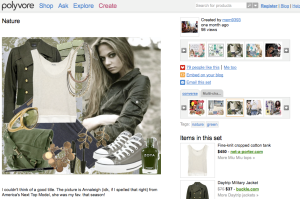No one has popularized the benefits of behavioral analytics more than Google, and within a year of Google Analytics’ launch, many web analytics firms vanished. Anyone, regardless of technical savvy, could track activity on their website easily and for FREE!
More and more apps are popping up, attracting droves of users who happily engage, providing mountains of personal preference information in exchange for an opportunity to play. LinkedIn is a fabulous example of how CEOs and students alike share LOTS of important information in exchange for being visible. Even the CEOs know that it’s no longer smart to be invisible or silent on the web.
Recently, I ran across another cool social app that is quietly gathering mountains of important data, but its users could care less. They just want to play, and in fact, have recreated the old game of paper dolls for the web. A website called Polyvore.com allows users to use images of real clothes, and, with an electronic scissor called The Clipper, collect those items (usually clothing found on any fashion site on the web) in a virtual closet which can be viewed by any of the 6.6 million other visitors to Polyvore each month. With a simple drag and drop, an ensemble is created, essentially an online collage that can be shared with others, all free of charge, and just for fun.
The site has 1.4 million registered users, 200,000 of whom are dedicated creators — amateur fashion designers who assemble, collectively, 30,000 ensembles a day posted to Twitter, Facebook or personal blogs.
A recent article in The New Yorker (“Fashion Democracy,” March 29, 2010) featured Jess Lee, Polyvore’s 27-year-old Vice President of Product Management. Lee says, “Our mission is to democratize fashion — to empower people on the street to think about their sense of style and share it with the world.”
“Part of the company’s business plan involves selling the statistics it’s tabulating (which Lee called “a gold mine of analytics”), to designers, to store buyers, in order to manage inventory more effectively.
“We have so much data about what is being matched with what,” said Lee, a dedicated set-maker who, like other regulars, calls herself a Polywhore. “If I click on Calvin Klein, do I also click on Helmut Lang? Are gladiator sandals going in or out? Are skinny jeans about to die?”
This is the perfect recipe for gathering valuable information on what fashion lovers would love to buy and wear, before they ever spend a dime. Plus, it will help stores offer more of what customers really want, with their customers dictating what’s next.
Resources:
“Fashion Democracy”, The New Yorker, March 29, 2010, pages 52-57
About the Author:
Barb Cote serves as the Creative Director at SIGMA Marketing Group. Connect with Barb on or follow her on .



{ 1 trackback }